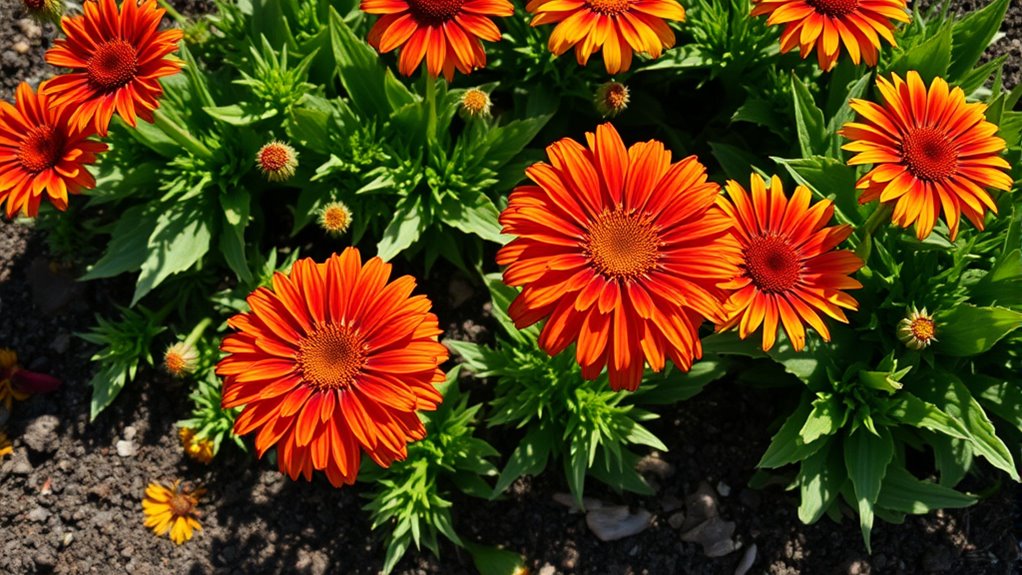If your blanket flowers are dying, the main issues could be poor soil, lack of sunlight, or neglecting deadheading. Guarantee your soil drains well, is slightly acidic to neutral, and has enough nutrients by adding compost or manure. Make sure they get at least 6 hours of direct sun daily. Regularly deadhead spent blooms to promote reblooming. For more tips on fixing and maintaining healthy blanket flowers, keep exploring these essential care practices.
Key Takeaways
- Ensure soil is well-draining, moderately fertile, and slightly acidic to neutral (pH 6.0-7.0); amend with compost if needed.
- Provide at least 6 hours of full sun daily to promote healthy growth and abundant flowering.
- Regularly deadhead spent blooms to encourage reblooming and prevent seed formation.
- Monitor for pests and diseases, and treat early to prevent plant decline or death.
- Maintain proper watering practices and improve drainage to avoid waterlogged soil and root rot.
Understanding Your Blanket Flowers’ Soil Needs
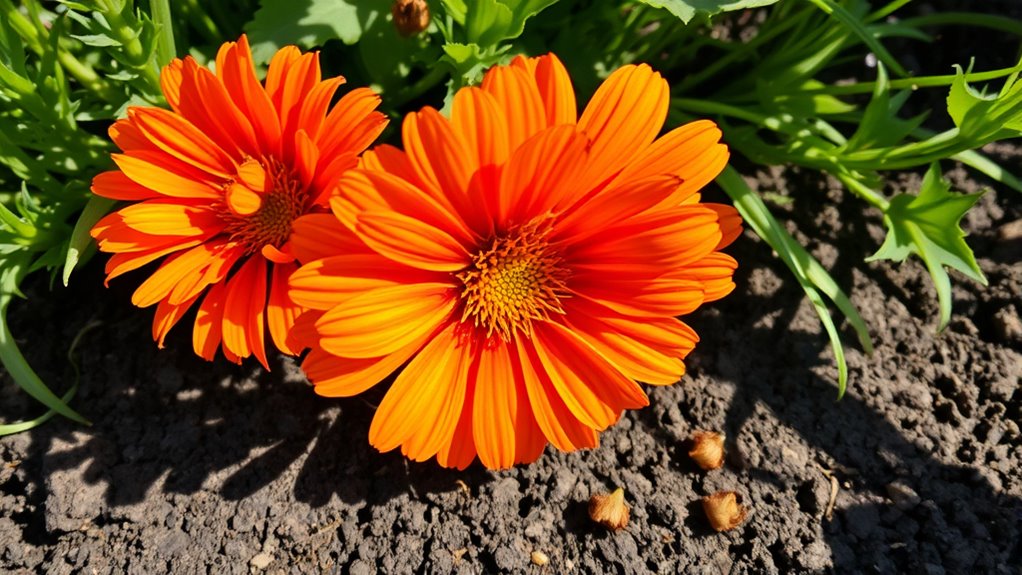
To keep your blanket flowers healthy, understanding their soil needs is essential. These plants thrive in well-draining soil with moderate fertility. To improve your soil, consider adding organic soil amendments like compost or aged manure to boost nutrients and enhance drainage. Avoid heavy clay or overly compacted soil, which can cause root rot. Regular fertilizer application helps maintain vibrant blooms and healthy growth; a balanced, slow-release fertilizer works well. Apply fertilizer in spring and mid-summer, following package instructions. Keep the soil slightly acidic to neutral, around pH 6.0 to 7.0. Ensuring proper soil conditions can also prevent common issues like soil compaction, which restricts root development. Using soil testing kits can help you monitor and adjust soil pH effectively. Proper soil management can enhance plant health and support continuous flowering. By adjusting your soil with amendments and applying fertilizer properly, you’ll create a supportive environment that promotes strong roots and continuous flowering.
Ensuring Adequate Sunlight for Vibrant Blooms
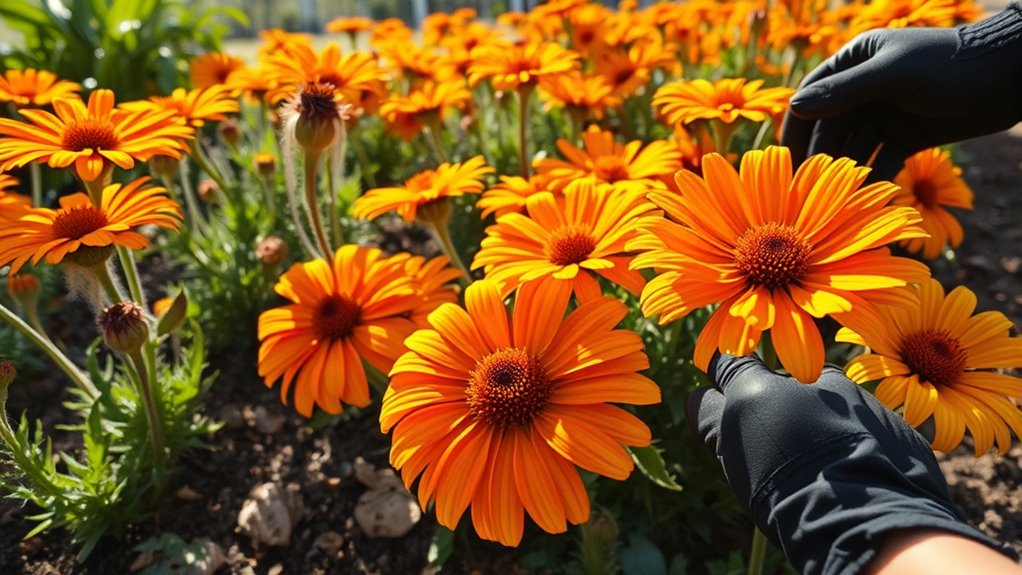
Ensuring your blanket flowers receive enough sunlight is essential for producing their vibrant, eye-catching blooms. These plants thrive with full sun, requiring at least 6 hours of direct sunlight daily. While they tolerate some shade, their shade tolerance is limited; too much shade results in leggier growth and fewer flowers. To maximize blooms, choose a planting spot with unobstructed sunlight. If you notice sparse flowering, check if your plants are getting enough sun. Adjust their location if necessary. Remember, consistent sunlight helps maintain healthy growth and vibrant color. For optimal results, consider plant placement and ensure the area is free from shadows cast by nearby structures. Here’s a quick guide:
| Sunlight Requirement | Shade Tolerance |
|---|---|
| At least 6 hours daily | Limited, prefers full sun |
| Full sun preferred | Tolerates some partial shade |
| More sun equals more blooms | Avoid deep shade |
| Adequate sunlight = healthy plants | Too much shade reduces flowering |
Recognizing and Addressing Watering Issues

Proper watering is essential for keeping your blanket flowers healthy and vibrant. Too much or too little water can cause stress, leading to wilting or dying plants. To address watering issues, focus on these key points:
Proper watering keeps blanket flowers healthy—adjust based on weather, ensure good drainage, and water deeply.
- Adjust your watering frequency based on weather and soil moisture—watering when the top inch of soil feels dry helps maintain ideal moisture retention.
- Ensure your soil drains well to prevent waterlogging, which can rot roots and harm your plants.
- Use deep, infrequent watering rather than frequent shallow watering to encourage strong roots and better moisture retention.
- Incorporating drainage improvements can further help prevent water buildup and promote healthier plant growth. Additionally, considering soil pH levels can optimize nutrient availability and overall plant health.
The Importance of Proper Deadheading and Pruning

Regular deadheading and pruning are essential for keeping your blanket flowers looking their best and encouraging continuous blooms. Using proper pruning techniques, you remove spent flowers to prevent seed production, which helps the plant focus energy on new growth. Deadheading also maintains a tidy appearance and promotes a lush, full flower bed design. When pruning, cut back stems just above a set of healthy leaves or buds to stimulate reblooming. Avoid over-pruning, which can weaken the plant. Consistent deadheading throughout the growing season ensures your blanket flowers stay vibrant and healthy. Incorporating artistic planter designs into your garden can enhance the visual appeal of your flower beds and create a more inviting outdoor space. Incorporate deadheading into your regular garden routine for the best results, and you’ll enjoy a colorful, flourishing flower bed all season long.
Dealing With Pests and Diseases
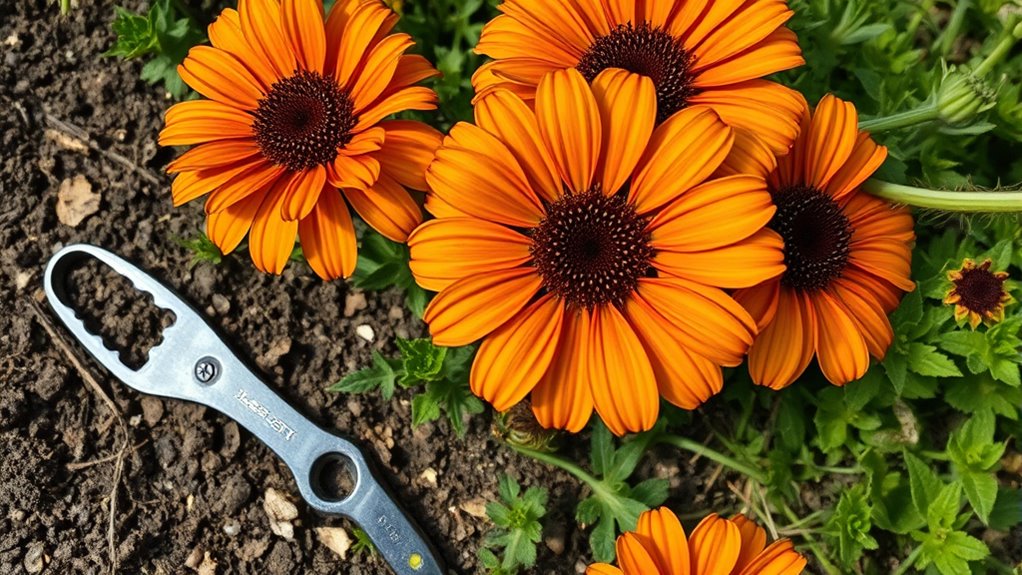
You need to watch for common pests like aphids, spider mites, and slugs that can harm your blanket flowers. Recognizing early signs of disease, such as spots or wilting, helps you take quick action. Using targeted treatments and maintaining plant health are key to controlling pests and diseases effectively.
Common Pests Attacking Blanket Flowers
While blanket flowers are generally hardy, they can fall prey to several common pests that threaten their health. Keeping an eye out for these pests helps protect your plants. Here are the main culprits:
- Aphids – tiny sap-sucking insects that cause curling leaves and stunted growth. Regularly inspect your plants and use natural predators or insecticidal soap.
- Spider mites – these pests create fine webbing and weaken the plant. Increase humidity with mulch application and consider companion planting with herbs like basil to deter them.
- Whiteflies – often found on the underside of leaves, they suck sap and cause yellowing. Maintain good airflow and healthy soil to reduce their presence.
- Monitoring for pests is essential, especially since pinball machines have evolved to include advanced technology that can help identify infestations early. Additionally, understanding the Integrated Pest Management approach can enhance your pest control strategies and minimize chemical use.
Proper companion planting and mulch application can help prevent pest infestations and support your blanket flowers’ resilience.
Recognizing Disease Symptoms Early
Early detection of disease symptoms is crucial for effectively managing problems with your blanket flowers. Look for signs such as wilting, discolored leaves, or soft, mushy stems, which can indicate root rot or fungal infestations. Recognizing these early symptoms helps prevent the spread and saves your plants. Here’s a quick comparison:
| Symptom | Possible Cause |
|---|---|
| Wilting despite watering | Root rot or fungal issues |
| Discolored or blackened leaves | Fungal infestations |
| Soft, mushy stems | Root rot |
| Powdery or fuzzy growth | Fungal infections |
Act quickly if you notice these signs, as early intervention limits damage and improves recovery chances. Regular inspection is your best defense against widespread disease.
Effective Pest and Disease Control
To effectively control pests and diseases on blanket flowers, prompt action is essential. Start by monitoring your plants regularly for signs of trouble. Here are three key steps:
- Practice companion planting with herbs like garlic or marigolds to deter pests naturally. Incorporating natural pest deterrents can enhance your garden’s defenses. Additionally, selecting plants with distinctive features can help attract beneficial insects that prey on pests.
- Use soil amendments such as compost or organic matter to boost plant health, making them less susceptible. Healthy soil promotes stronger plants capable of resisting infections.
- Remove and dispose of any infected leaves or flowers immediately to prevent disease spread. Incorporating aesthetic wall organization can also help keep your garden tidy and reduce hiding spots for pests. Regularly rotating crops and maintaining proper watering techniques further support plant vitality.
Seasonal Care Tips to Keep Blanket Flowers Healthy
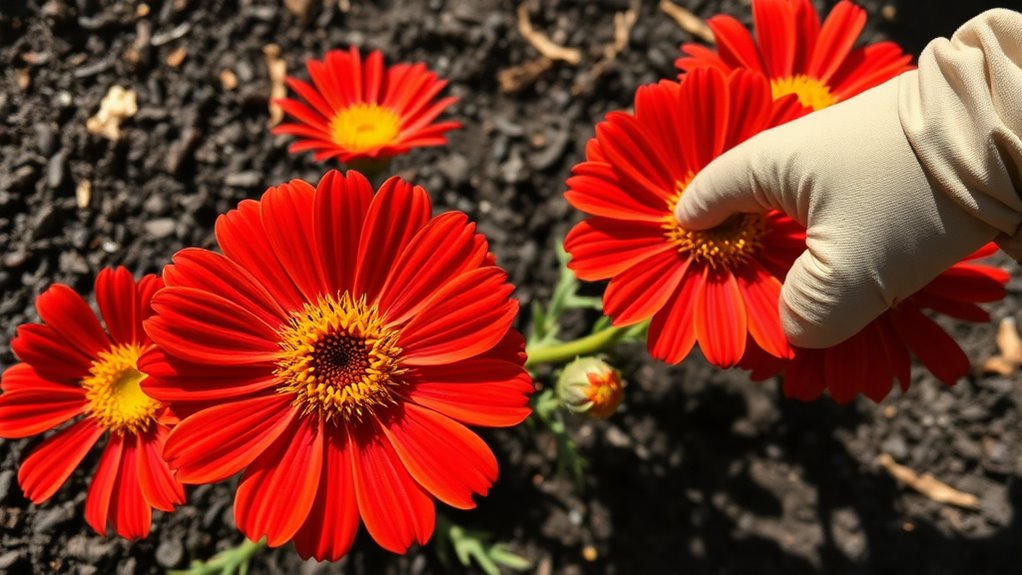
Proper seasonal care is essential to keep your blanket flowers healthy and vibrant. During the growing season, pay attention to fertilizer requirements; use a balanced, slow-release fertilizer every 6-8 weeks to promote strong blooms and foliage. Mulching strategies also play a crucial role in maintaining plant health. Apply a layer of organic mulch around the base of your plants to conserve moisture, suppress weeds, and regulate soil temperature. In colder months, add a thicker mulch to protect roots from freezing temperatures. During summer heatwaves, mulch helps prevent soil from drying out too quickly. Regular deadheading combined with proper fertilization and mulching keeps blanket flowers vigorous, encourages continuous blooming, and prevents stress that can lead to decline. Additionally, maintaining proper soil drainage ensures the roots do not become waterlogged, which is vital for overall plant health. Incorporating soil health practices can further improve nutrient availability and plant resilience. Furthermore, practicing space and organization in garden care can help you keep track of your seasonal tasks and ensure each plant receives appropriate attention.
Frequently Asked Questions
Can Blanket Flowers Survive in Containers or Limited Space?
Yes, blanket flowers thrive in containers, making them perfect for container gardening. They adapt well to limited space when you choose a appropriately sized pot with good drainage. To optimize space, plant them in groups or use vertical arrangements. Regular deadheading encourages blooms, and guarantee they get plenty of sunlight. With proper space optimization, your blanket flowers will flourish and add vibrant color to any small garden or patio.
What Specific Soil Amendments Boost Blanket Flower Health?
To boost your blanket flower’s health, focus on soil improvement through organic matter like compost or well-aged manure, which enhances drainage and aeration. Incorporate slow-release fertilizers for nutrient management, providing consistent nourishment. Avoid heavy clay or overly sandy soils, as they hinder growth. Regularly amend your soil to maintain proper pH and nutrient levels, creating an suitable environment that encourages vibrant blooms and strong plants.
How Do Temperature Fluctuations Affect Blanket Flower Vitality?
Temperature fluctuations are like a roller coaster ride for your blanket flowers, impacting their vitality during seasonal transitions. Sudden temperature stress can cause stress, making plants weaken or die back prematurely. To keep them thriving, make certain they’re protected from extreme swings, especially at night. Consistent watering and mulching help buffer temperature changes. Remember, stability during seasonal shifts helps your blanket flowers stay strong and vibrant all season long.
Are There Natural Remedies for Common Blanket Flower Pests?
You can manage blanket flower pests naturally by using companion planting with herbs like basil or marigolds, which repel insects. Applying natural repellents such as neem oil or insecticidal soap also helps keep pests at bay. Regularly inspecting your plants and removing affected foliage prevents infestations. These eco-friendly methods protect your blanket flowers while maintaining a healthy garden, ensuring vibrant blooms without resorting to chemicals.
How Can I Encourage Longer Blooming Periods?
Think of your blanket flowers like a dance partner needing the right rhythm. To extend their bloom, adjust your watering schedule to keep the soil consistently moist but not soggy. Use proper fertilization techniques, like a balanced 10-10-10 formula, every few weeks. Deadhead regularly to encourage new flowers. These steps help your plants stay lively longer, much like a well-choreographed performance that keeps the audience captivated.
Conclusion
By paying attention to your blanket flowers’ soil, sunlight, watering, and pruning, you set yourself up for success. Keep a watchful eye for pests and diseases, and adjust your care as seasons change. Remember, a little effort goes a long way—if you nurture them properly, your blooms will flourish and brighten your garden. Don’t throw in the towel too soon; with patience and care, your flowers can bounce back and thrive.
